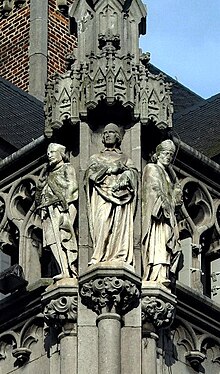
Ratherius (887–890 AD – 974 AD) or Rathier or Rather of Verona was a teacher, writer, and bishop. His difficult personality and political activities led to his becoming an exile and a wanderer.

Ratherius (887–890 AD – 974 AD) or Rathier or Rather of Verona was a teacher, writer, and bishop. His difficult personality and political activities led to his becoming an exile and a wanderer.
He was born sometime between 887 and 890 AD into a noble family in the territory of Liège. While still a boy, Ratherius was sent as an oblate to Lobbes Abbey, belonging to the Order of Saint Benedict in the County of Hainaut. He was a diligent student and later became a monk there. At an early age, he was described as being restless, difficult to get along with, ambitious, and overly zealous. Consequently, despite his strict orthodoxy, wide learning, and good conduct, he met with difficulties in every position he assumed and failed to attain lasting success. He spent his life wandering fruitlessly. [1] As presiding bishop, he once commented that if he attempted to enforce the canons against unchaste persons who administered ecclesiastical rites, the Church would be without anyone except boys. Furthermore, if he put into effect canons against bastards, they would also be excluded. [2]
When Abbot Hilduin of Lobbes went in to Italy in 926, he took Ratherius with him as a companion. Hilduin's cousin, Hugh of Italy was the current king, and after many difficulties, Ratherius received the Diocese of Verona from him in 931. Yet he only ruled his see for two years, soon quarrelling with members of his diocese and with the king. The king sent him to prison and had him brought to Como; in 939 he escaped from Como into Provence, becoming a tutor in a noble family until he returned to the Abbey of Lobbes in 944. [1]
In 946 he traveled again to Italy and, after being held for some time as a prisoner by Berengar II of Italy, (opponent of King Hugo), regained the Diocese of Verona. The difficulties that arose were again so great that after two years he fled to Germany and for some time wandered about the country. He took part in the expedition to invade Lombardy with Liudolf, Duke of Swabia, the son of Otto I, Holy Roman Emperor, but was unable to regain his diocese; so in 952, he returned again to Lobbes. [1]
From Lobbes Abbey, Ratherius was called to the cathedral school of Cologne by Archbishop Bruno of Cologne who in 953, gave Ratherius the Diocese of Liège. However, as early as 955, a revolt against him by the nobility obliged Ratherius to give up this see, and he retired to Aulne Abbey. In 962 the Diocese of Verona was restored to him by Emperor Otto but after seven years of constant quarrels he was obliged once more to withdraw. In 968 he went to Lobbes, where he incited such opposition against the Abbot Folcwin that Bishop Notker of Liège restored order by force, and in 972 sent Ratherius back to the Abbey of Aulne, where he remained until his death at Namur on 25 April 974. [1]
Ratherius was also a fine preacher: one of his strengths was his skill in reviving old ideas and making them new again [1] He was one of the first to employ the use of fables to illustrate his sermons, and respected ordinary intelligence, speaking against "swollen rhetoric". [1]
His writings are as unsystematic as his life was changeable and tumultuous. While his style is confused and lacks clarity, his writings generally made reference to particular occasions, and were pamphlets and invectives against his contemporaries. He also wrote complaints against himself in his own affairs. [1] In one of his Verona sermons, Rather mentions reading the Latin poet Catullus in 966, which makes him a figure in the tenuous transmission of Catullus medieval manuscripts.
While imprisoned in Pavia, Ratherius wrote Praeloquia, criticizing all social ranks of the period. [1]
His other writings include: [1]
Some of his sermons and letters have also been preserved. The writings shine light upon his era. His works were edited by the brothers Ballerini (Verona, 1765); also in Patrologia Latina , CXXXVI. Unedited letters are to be found in Studi e documenti di storia e diritto (1903) 51–72. [1]

Bernard of Clairvaux, O.Cist., venerated as Saint Bernard, was an abbot, mystic, co-founder of the Knights Templar, and a major leader in the reform of the Benedictines through the nascent Cistercian Order.

Year 974 (CMLXXIV) was a common year starting on Thursday of the Julian calendar.

Thuin is a city and municipality of Wallonia located in the province of Hainaut, Belgium.

Denis of France was a 3rd-century Christian martyr and saint. According to his hagiographies, he was bishop of Paris in the third century and, together with his companions Rusticus and Eleutherius, was martyred for his faith by decapitation. Some accounts placed this during Domitian's persecution and incorrectly identified St Denis of Paris with the Areopagite who was converted by Paul the Apostle and who served as the first bishop of Athens. Assuming Denis's historicity, it is now considered more likely that he suffered under the persecution of the emperor Decius shortly after AD 250.

Berengar I was the king of Italy from 887. He was Holy Roman Emperor between 915 and his death in 924. He is usually known as Berengar of Friuli, since he ruled the March of Friuli from 874 until at least 890, but he had lost control of the region by 896.
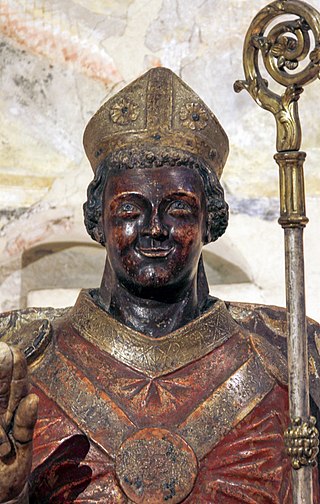
Zeno of Verona was an Afro-Italian Christian figure believed to have either served as Bishop of Verona or died as a martyr. He is venerated as a saint in the Catholic Church and the Orthodox Church.

Hilduin was Bishop of Paris, chaplain to Louis I, reforming Abbot of the Abbey of Saint-Denis, and author. He was one of the leading scholars and administrators of the Carolingian Empire.
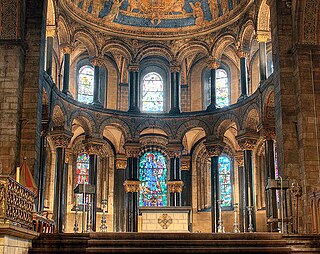
Mosan art is a regional style of art from the valley of the Meuse in present-day Belgium, the Netherlands, and Germany. Although in a broader sense the term applies to art from this region from all periods, it generally refers to Romanesque art, with Mosan Romanesque architecture, stone carving, metalwork, enamelling and manuscript illumination reaching a high level of development during the 11th, 12th and 13th centuries.

Nonantola Abbey, dedicated to Saint Sylvester, is a former Benedictine monastery and prelature nullius in the commune of Nonantola, c. 10 km north-east of Modena, in the Emilia Romagna region of Italy. The abbey church remains as a basilica and is the co-cathedral of the diocese of Modena-Nonantola.

Aulne Abbey was a Cistercian monastery located between Thuin and Landelies on the river Sambre in the Bishopric of Liège, Belgium. It is now a Walloon Heritage Site.
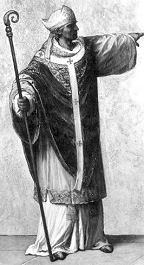
Notkerof Liège was a Benedictine monk, bishop (972–1008) and first prince-bishop (980–1008) of the Bishopric of Liège.
Herigerus was a Benedictine monk, often known as Heriger of Lobbes for serving as abbot of the abbey of Lobbes between 990 and 1007. Remembered for his writings as theologian and historian, Herigerus was a teacher to numerous scholars. His biography describes him as "skilled in the art of music", though no music theory treatise survives and neither do the two antiphons and one hymn attributed to him.

The Diocese of Verona is a Latin diocese of the Catholic Church in northern Italy. The diocese belongs to the Ecclesiastical Province of Venice. The bishop of Verona has his seat in Verona, Veneto. The episcopal throne is in the cathedral, which had originally been dedicated to S. Maria Matricolare and S. George.
Geoffrey of Clairvaux, or Geoffrey of Auxerre, was the secretary and biographer of Bernard of Clairvaux and later abbot of a number of monasteries in the Cistercian tradition.

Lobbes Abbey was a Benedictine monastery in the municipality of Lobbes, Hainaut, Belgium. The abbey played an important role in the religious, political and religious life of the Prince-Bishopric of Liège, especially around the year 1000. The abbey's founding saint is Saint Landelin; four other saints are also connected with the abbey.

Saint Landelin is a saint in the Eastern Orthodox Church and Roman Catholic Church.

Gian Matteo Giberti was an Italian diplomat, Bishop of Verona.

Henri Arnauld (1597–1692) was a French Catholic bishop.
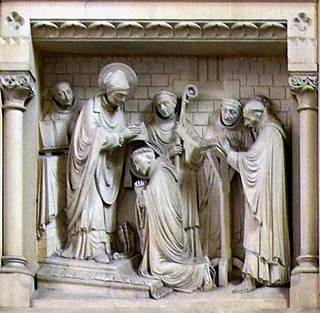
Ursmar of Lobbes was a missionary bishop in the Meuse and Ardennes region in present-day Belgium, Germany, Luxemburg and France. He was also the first abbot of Lobbes Abbey.
Hydulphe, Hydulphus, Hidulphe, Hidulf, commonly known as Hydulphe of Lobbes(French: Hydulphe de Lobbes) was a Frankish saint who helped Saint Landelin establish Lobbes Abbey, Crespin Abbey, and Aulne Abbey.
![]() This article incorporates text from a publication now in the public domain : Herbermann, Charles, ed. (1913). "Ratherius of Verona". Catholic Encyclopedia . New York: Robert Appleton Company.
This article incorporates text from a publication now in the public domain : Herbermann, Charles, ed. (1913). "Ratherius of Verona". Catholic Encyclopedia . New York: Robert Appleton Company.